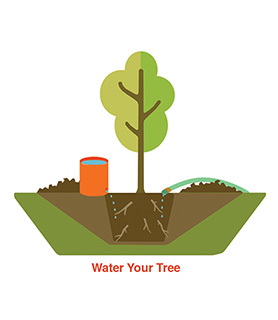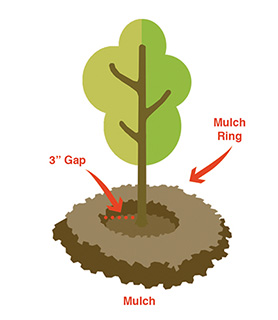Before bringing home a yard tree, consider where you will plant your tree and how you will get it home. Follow the simple tips below to help it survive and thrive. If you have questions about trees or how to take care of your tree, call or email the TreePhilly Team for some advice.
Yard TreeCare Guide
Árboles de PatioSiembra y Cuidado
Get YourTree Home Safely
Skip To:
Where to Plant Your Tree
Water!
Mulch
Prune
Keep Clean and Weed
Protect
Loosen Soil
Stake Leaning Trees
Do not fertilize!
Where to plant your yard tree is a big decision! Check out our Tree Siting Guide and follow these tips to make sure you plant the right tree in the right place.
Still not sure where to plant? Check out these tips from the Arbor Day Foundation and the US Forest Service.

Water!
Young trees need water to survive and thrive! For the first two years after planting, give your tree 10 gallons of water once or twice per week from when you first see buds and leaves in the spring until the leaves have dropped in the fall (generally March through December). Stay aware of the weather! If it has rained a lot this week, water your tree less. If it had been dry and hot, give your tree an extra big drink. Watering slowly and near the trunk helps the water soak deep into the soil so all the roots can absorb the water gradually.
Here are some of our favorite watering methods:

Mulch
Mulching your tree helps it to keep its roots moist, stay cool in the summer and warm in the winter, reduces competition from other plants, and protect the tree from lawnmowers.
Use organic composted mulch, wood chips, or pine needles to make a ring of mulch around your tree. Follow the rule of 3-3-3: make the ring 3’ wide and 3’’ deep and leave a 3’’ gap between the mulch and the tree’s trunk so the root flare at the base of the trunk is still exposed to the air. When finished, the mulch should look like a donut (a wide, flat circle). Avoid mulch volcanoes or a tall pile of mulch around the tree’s trunk.
Apply fresh mulch to your tree each spring, making sure to remove mulch that has been contaminated by de-icing salts or dog waste. Avoid using non-organic materials like rocks/gravel, bricks, or rubber.
Philly residents can get free mulch at the Fairmount Park Organic Recycling Center!
Prune
Prune only dead, diseased, or damaged branches in the first two years after you plant your tree.
After the first two years, when your tree is established in its new home, it’s best to lightly prune your trees every 2-3 years. Unless limbs are dead, diseased, or dying, it is best to prune your tree in the fall and winter when the trees are dormant and you have a clear view of any weak or crossing limbs.
Fruit tree require special pruning care, but with practice your will reap the rewards! For information on fruit tree pruning, see Philly Orchard Project’s Pruning Guide or attend one of their pruning workshops.
Remember: Safety always comes first! Be careful to protect your head and your eyes while pruning your tree. If you need a ladder to prune your tree, please call an arborist.
Keep Clean and Weed
Make sure to protect your tree from toxic substances like pet waste, litter and garbage, cigarette butts, and rock salt or other chemical ice melting products. Grass and other plants can compete with your tree for root space and nutrients. We recommend keeping your tree’s root zone mulched and free of grass, weeds, and other plants.
Protect
Make sure to protect your tree from lawnmowers, cars, bicycles, and deer can quickly and easily damage the bark and trunk. Mulching the base of your tree, installing a tree guard or wire cage around your tree can help protect its fragile bark. Be sure to check on the tree guard each year to make sure the tree has enough room to grow!
Loosen Soil
Using a hand trowel or small shovel, loosen the top 2-3” of soil around the base of your tree, which will help water to penetrate the soil and reach the roots. Just be careful not to damage the roots!
Stake leaning trees
Trees do not usually need staking. Only stake your young tree if it is leaning or you live somewhere that experiences a lot of rain or very loose, wet soil.To stake a leaning tree you will need one or two wooden or metal stakes and arbor tie or another soft material that will not damage the vulnerable bark. Identify where on the tree’s trunk needs to be steadied. This is how high your stakes will need to be Place the stakes 1.5′ away from the tree in the opposite direction from where the tree is leaning. Loosely tie the arbor tie around the stake and the tree, leaving enough slack so the tree can sway in the wind. Do not use wire or rope to tie the tree back. These materials can injure or even kill your tree. Remove the stakes after one year. Properly watering and caring for your tree can help your tree develop a healthy root system that will support the tree once the stakes are removed.
Do not fertilize!
Trees do not need fertilizer, chemicals, or potting soil to thrive. In fact, applying these materials to young and newly planted trees often results in shock, which can easily kill your tree. Fertilizer should only be used as medicine if you know that the tree is sick or in need of special care. Also avoid using weed killers and herbicides near your tree, especially those that kill broad-leaved weeds as these can harm or even kill your tree.
Philadelphia Parks & Recreation can only provides pruning and removal services for street trees. We cannot offer pruning or removal services for yard trees on private property.
If you are worried that your tree is diseased or infested, please call a certified arborist. If the tree is so large that you cannot prune it with both feet on the ground, please call a certified arborist. Make sure the arborist is certified and in good standing with the International Society of Arboriculture (ISA) by checking online by clicking here or by calling the Penn-Del ISA Chapter at (717) 412-7473.